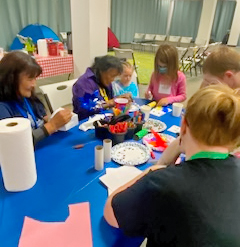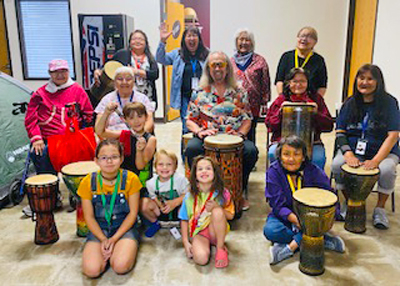Culture Camps
By Cole Ward
Past literature has described American Indian and Alaska Native Elders as keepers of knowledge communicating their wisdom, creating the foundation for future generations (Kahn, Reinschmidt, Teufel-Shone, Ore, Henson, & Attakai, 2018). Unfortunately, existing literature has also documented a trend of disconnect between Native generations, which has caused tribal nations to invest in programs that reconnect Elders with youth (Goodkind, Hess, Gorman, & Parker, 2012; Tyer, 2015).
Yet, the experiences and life stories from Elders, which hold lessons for all generations, can be key to the development of rich American Indian or Alaska Native cultural identity and life skills.
Over the years, tribes and Native people have looked for ways to keep their culture alive and pass it on to the next generation. For many Elders, culture is defined as knowledge and values centered around knowing their tribal roots, history, and engaging in cultural activities (Kahn et al, 2018).
Transfer of Knowledge
 Recently, tribal programs, such as Title VI programs, have turned to “culture camps” as a way for
Elders to stay engaged and active in their daily lives. Culture camps, which can last one or more days, allow
Native Elders and youth to participate in traditional events. In a sense, the event is a transfer of
knowledge from teacher to student. However, for Native people who participate, it is a preservation of
culture, language, stories, songs, and life skills.
Recently, tribal programs, such as Title VI programs, have turned to “culture camps” as a way for
Elders to stay engaged and active in their daily lives. Culture camps, which can last one or more days, allow
Native Elders and youth to participate in traditional events. In a sense, the event is a transfer of
knowledge from teacher to student. However, for Native people who participate, it is a preservation of
culture, language, stories, songs, and life skills.
Yet, the process is two-fold, as Elders are able to stay involved in their communities and have their value undiminished, maybe even increased. During culture camps, Elders introduce themselves by their traditional names and continue conversations in their native language, which may be the first time children have heard it.
Teaching Traditions
In Fairbanks, Alaska, at Fairbanks Native Association (FNA), Karen Eddy, Title VI director, highlighted how youngsters looked at Elders with awe and soaked in all the knowledge presented while learning where their ancestors came from. Elders would speak to them in their native language, read books together, and show them where their traditional homelands were. And, equally as important, Elders enjoyed sharing their knowledge with the children.
 In addition to language, song, and dance, Elders teach younger generations how their ancestors lived and
survived before present day circumstances. For instance, Elders possess the knowledge of hunting or
catching wild game, gathering fruits and vegetables, and preparing meals. This knowledge is so great and
revered that some tribes and villages have elicited the help of Elders during hunting season to have them
teach younger generations how to harvest and clean the animals they catch.
In addition to language, song, and dance, Elders teach younger generations how their ancestors lived and
survived before present day circumstances. For instance, Elders possess the knowledge of hunting or
catching wild game, gathering fruits and vegetables, and preparing meals. This knowledge is so great and
revered that some tribes and villages have elicited the help of Elders during hunting season to have them
teach younger generations how to harvest and clean the animals they catch.
Similar to language, activities such as these promote a sense of belonging and connection with one's tribal community, heritage, and traditional lifestyle. For example, traditional activities help generations of Natives understand their roles in life and that there is a connection between them and nature (Kahn et al, 2018). Put differently, Native youth are able to understand that their place in society is one of many working together.
Exploring History
 Yet, and perhaps most importantly, the teachings Elders provide give Native youth an understanding of the
history of their tribe or village and the historical trauma Natives before them experienced. By sharing
stories, Elders communicate the racism and discrimination they experienced while instilling pride and
personal strength to overcome modern challenges. In other words, Elders are passing on resiliency
strategies.
Yet, and perhaps most importantly, the teachings Elders provide give Native youth an understanding of the
history of their tribe or village and the historical trauma Natives before them experienced. By sharing
stories, Elders communicate the racism and discrimination they experienced while instilling pride and
personal strength to overcome modern challenges. In other words, Elders are passing on resiliency
strategies.
By sharing stories of survival through the boarding schools and assimilation, Elders are passing on their resiliency and self-determination to Native youth. Overall, the teachings Elders provide to younger generations underscore the importance of positive character traits such as responsibility, good work ethic, and standing up for yourself while respecting those around you (Kahn et al, 2018).